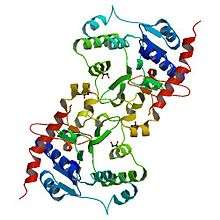Glycogenin
Glycogenin is an enzyme involved in converting glucose to glycogen. It acts as a primer, by polymerizing the first few glucose molecules, after which other enzymes take over. It is a homodimer of 37-kDa subunits and is classified as a glycosyltransferase.
| glycogenin glucosyltransferase | |||||||||
|---|---|---|---|---|---|---|---|---|---|
 Glycogenin structure (from rabbit).[1] | |||||||||
| Identifiers | |||||||||
| EC number | 2.4.1.186 | ||||||||
| CAS number | 117590-73-5 | ||||||||
| Databases | |||||||||
| IntEnz | IntEnz view | ||||||||
| BRENDA | BRENDA entry | ||||||||
| ExPASy | NiceZyme view | ||||||||
| KEGG | KEGG entry | ||||||||
| MetaCyc | metabolic pathway | ||||||||
| PRIAM | profile | ||||||||
| PDB structures | RCSB PDB PDBe PDBsum | ||||||||
| |||||||||
It catalyzes the chemical reaction:
- UDP-alpha-D-glucose + glycogenin ⇌ UDP + alpha-D-glucosylglycogenin
Thus, the two substrates of this enzyme are UDP-alpha-D-glucose and glycogenin, whereas its two products are UDP and alpha-D-glucosylglycogenin.
Nomenclature
This enzyme belongs to the family of glycosyltransferases, specifically the hexosyltransferases. The systematic name of this enzyme class is UDP-alpha-D-glucose:glycogenin alpha-D-glucosyltransferase. Other names in common use include:
- glycogenin,
- priming glucosyltransferase, and
- UDP-glucose:glycogenin glucosyltransferase.
One may also notice that the naming of glycogenin hints at its function, with the glyco prefix referring to a carbohydrate and the genin suffix derived from the Latin genesis meaning novel, source, or beginning. This hints at the role of glycogenin to simply start glycogen synthesis before glycogen synthase takes over.
Discovery
Glycogenin was discovered in 1984 by Dr. William J. Whelan, a fellow of the Royal Society of London and current professor of Biochemistry at the University of Miami.[2]
Function
The main enzyme involved in glycogen polymerisation, glycogen synthase in the liver and in the muscle glycogen synthesis is initiated by UDP-Glucose, can only add to an existing chain of at least 3 glucose residues. Glycogenin acts as the primer, to which further glucose monomers may be added. It achieves this by catalyzing the addition of glucose to itself (autocatalysis) by first binding glucose from UDP-glucose to the hydroxyl group of Tyr-194. Seven more glucoses can be added, each derived from UDP-glucose, by glycogenin's glucosyltransferase activity. Once sufficient residues have been added, glycogen synthase takes over extending the chain. Glycogenin remains covalently attached to the reducing end of the glycogen molecule.
Evidence accumulates that a priming protein may be a fundamental property of polysaccharide synthesis in general; the molecular details of mammalian glycogen biogenesis may serve as a useful model for other systems.
Structure
Isozymes
In humans, there are two isoforms of glycogenin — glycogenin-1, encoded by GYG1, and expressed in muscle; and glycogenin-2, encoded by GYG2,and expressed in the liver and cardiac muscle, but not skeletal muscle. Patients have been found with defective GYG1, resulting in muscle cells with the inability to store glycogen, and consequential weakness and heart disease.[4]
|
| ||||||||||||||||||||||||||||||||||||||||||||||
References
- PDB: 1LL3; Gibbons BJ, Roach PJ, Hurley TD (May 2002). "Crystal structure of the autocatalytic initiator of glycogen biosynthesis, glycogenin". J. Mol. Biol. 319 (2): 463–77. doi:10.1016/S0022-2836(02)00305-4. PMID 12051921.
- Whelan WJ (September 1998). "Pride and prejudice: the discovery of the primer for glycogen synthesis". Protein Sci. 7 (9): 2038–41. doi:10.1002/pro.5560070921. PMC 2144155. PMID 9761486.
- Katch, Victor L.; McArdle, William D.; Katch, Frank I. (2007). Exercise physiology: energy, nutrition, and human performance. Philadelphia: Lippincott Williams and Wilkins. p. 12. ISBN 978-0-7817-4990-9.
- Moslemi AR, Lindberg C, Nilsson J, Tajsharghi H, Andersson B, Oldfors A (April 2010). "Glycogenin-1 deficiency and inactivated priming of glycogen synthesis". N. Engl. J. Med. 362 (13): 1203–10. doi:10.1056/NEJMoa0900661. PMID 20357282.
Further reading
- Krisman CR, Barengo R (1975). "A precursor of glycogen biosynthesis: alpha-1,4-glucan-protein". Eur. J. Biochem. 52 (1): 117–23. doi:10.1111/j.1432-1033.1975.tb03979.x. PMID 809265.
- Pitcher J, Smythe C, Campbell DG, Cohen P (1987). "Identification of the 38-kDa subunit of rabbit skeletal muscle glycogen synthase as glycogenin". Eur. J. Biochem. 169 (3): 497–502. doi:10.1111/j.1432-1033.1987.tb13637.x. PMID 3121316.
- Pitcher J, Smythe C, Cohen P (1988). "Glycogenin is the priming glucosyltransferase required for the initiation of glycogen biogenesis in rabbit skeletal muscle". Eur. J. Biochem. 176 (2): 391–5. doi:10.1111/j.1432-1033.1988.tb14294.x. PMID 2970965.
- Berman, M.C. and Opie, L.A. (Eds.), Membranes and Muscle, ICSU Press/IRL Press, Oxford, 1985, p. 65-84.
- Rodriguez IR, Whelan WJ (1985). "A novel glycosyl-amino acid linkage: rabbit-muscle glycogen is covalently linked to a protein via tyrosine". Biochem. Biophys. Res. Commun. 132 (2): 829–36. doi:10.1016/0006-291X(85)91206-9. PMID 4062948.
- Lomako J, Lomako WM, Whelan WJ (1988). "A self-glucosylating protein is the primer for rabbit muscle glycogen biosynthesis". FASEB J. 2 (15): 3097–103. doi:10.1096/fasebj.2.15.2973423. PMID 2973423.
- Alonso MD, Lomako J, Lomako WM, Whelan WJ (1995). "Catalytic activities of glycogenin additional to autocatalytic self-glucosylation". J. Biol. Chem. 270 (25): 15315–9. doi:10.1074/jbc.270.25.15315. PMID 7797519.
- Alonso MD, Lomako J, Lomako WM, Whelan WJ (1995). "A new look at the biogenesis of glycogen". FASEB J. 9 (12): 1126–37. doi:10.1096/fasebj.9.12.7672505. PMID 7672505.
- Mu J, Roach PJ (1998). "Characterization of human glycogenin-2, a self-glucosylating initiator of liver glycogen metabolism". J. Biol. Chem. 273 (52): 34850–6. doi:10.1074/jbc.273.52.34850. PMID 9857012.
External links
| Wikimedia Commons has media related to Glycogenin. |
- glycogenin at the US National Library of Medicine Medical Subject Headings (MeSH)
- molbio.med.miami.edu
